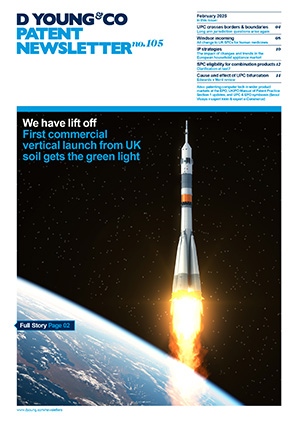G4/19: double patenting
As we previously reported, the Enlarged Board of Appeal recently issued a decision on G4/19, which addresses whether the EPO is permitted to refuse a European patent application on the basis of double patenting.
Double patenting generally refers to the idea by which an applicant is able to achieve multiple granted patents for the same subject-matter, although, as explained below, double patenting is more complicated than this statement might suggest.
There is no specific provision in the EPC that prohibits double patenting, and indeed some of the contracting states to the EPC permit it under their national laws. The EPO had previously concluded (via obiter statements made in respect of G1/05 and G1/06) that an applicant has no legitimate interest in obtaining two patents for the same application. In practice, it has been possible to overcome an objection as to double patenting by adding a feature sufficient to render the scope of the claim different from that previously granted. However determining whether the scope of the claims is different can be somewhat subjective and hence there is uncertainty as to when double patenting applies.
As a reminder, the three questions that were put to the Enlarged Board of Appeal were:
1) Can a European patent application be refused under Article 97(2) EPC if it claims the same subject-matter as a European patent which was granted to the same applicant and does not form part of the state of the art pursuant to Article 54(2) and (3) EPC?
2.1) If the answer to the first question is yes, what are the conditions for such a refusal, and are different conditions to be applied depending on whether the European patent application under examination was filed
a) on the same date as, or
b) as a European divisional application (Article 76(1) EPC) in respect of, or
c) claiming the priority (Article 88 EPC) in respect of a European patent application on the basis of which a European patent was granted to the same applicant?
2.2) In particular, in the last of these cases, does an applicant have a legitimate interest in the grant of a patent on the (subsequent) European patent application in view of the fact that the filing date and not the priority date is the relevant date for calculating the term of the European patent under Article 63(1) EPC?
The first question
The first question put to the Enlarged Board of Appeal was essentially whether objections on the basis of double patenting are permitted. The Enlarged Board of Appeal concluded that yes, such objections are permitted.
The Enlarged Board of Appeal’s reasoning for this is extensive, but ultimately relies on both Article 125 EPC, which states that the EPO will take account of procedural law generally recognised in the contracting states, and the travaux préparatoires – the preparatory documents used in the formation of the EPC.
The issue of double patenting was considered in the travaux préparatoires, in the context of Article 125 EPC, and there was a majority view that this situation should not be allowed. The Enlarged Board of Appeal noted that that the lack of “unanimous support does not preclude it from being taken into account for interpreting the Convention” (paragraph 67) since the adoption of the convention only required a two-third majority and since any contracting state was entitled to not sign the convention.
The second question
The second question, in essence, asks when refusal is to take place and particularly asks whether the conditions for refusal differ for different “types” of double patenting. The Enlarged Board of Appeal concluded that the conditions for refusal are the same for each type of double patenting.
The "types" of double patenting are characterised by (a) where two applications for the same subject-matter were filed by the same applicant on the same day; (b) where a European divisional application was filed, which claims the same subject-matter as the parent application; and (c) where two applications have a common priority application and claim the same subject-matter.
To briefly summarise an argument as to why it is appropriate for different types of double patenting to be treated differently from each other, it is necessary to consider the maximum legal term that can be provided to a granted patent. The maximum term of a patent is 20 years from its filing date (not its effective or priority date). There is therefore a legitimate interest in filing a first patent application for an invention and then filing a further application to the same invention a year later (claiming priority back to the first application), since this results in an extra year’s protection. It could therefore be argued that, following the obiter statements made in G1/05 and G1/06, since there is indeed a legitimate reason for double patenting to be permitted where a common priority application is present, double patenting in this situation should be permitted.
It was argued that this position is supported by the travaux préparatoires, which refer to double patenting in the context of applications having the same filing date and not the same effective date. Following such arguments, the above scenario would be a permissible form of double patenting because the first and second applications would have different filing dates (although the same effective date).
The Enlarged Board of Appeal disagreed and stated that the comments in the travaux préparatoires were not written with the precision of a legal revision and so were to be interpreted as referring to the effective date rather than the filing date.
The Enlarged Board of Appeal therefore saw no reason to differentiate between the different types of double patenting and that all types of double patenting were disallowed.
The third question
The conclusion in respect of the second question was consider sufficiently responsive to the third question.
Consequences
Given the now explicit indication that even type (c) double patenting is disallowed, the practice of prosecuting European priority applications is likely to disappear.
A possible way out of a double patenting objection is indicated in paragraph 80 of the decision – specifically, a double patenting objection can only apply where there are overlapping designations under Article 79 EPC. However, since all states are designated by default now, this would require explicit withdrawal of certain states in order to avoid overlap.
A further unanswered question, despite requests for answers in the Amicus Curiae briefs, is what “same subject-matter” means in respect of double patenting. As noted in paragraph 15 of the decision, the answer to this question was not relevant to the referred case in which the claims of the two applications were identical. It therefore seems that there is no change in practice in respect of how objections to double patenting are handled with overlapping sets of claims or, indeed, one sets of claims that are strictly broader (or narrower) than another from the same applicant.
A still further question relates to what “same applicant” means in this context. For instance, if a first application is owned by a company X and a second application to the “same subject matter” is filed on the same day by a wholly owned subsidiary of company X, does this constitute the same applicant?
It is likely that further appeals will follow in due course in order to try and resolve some of these remaining questions.


